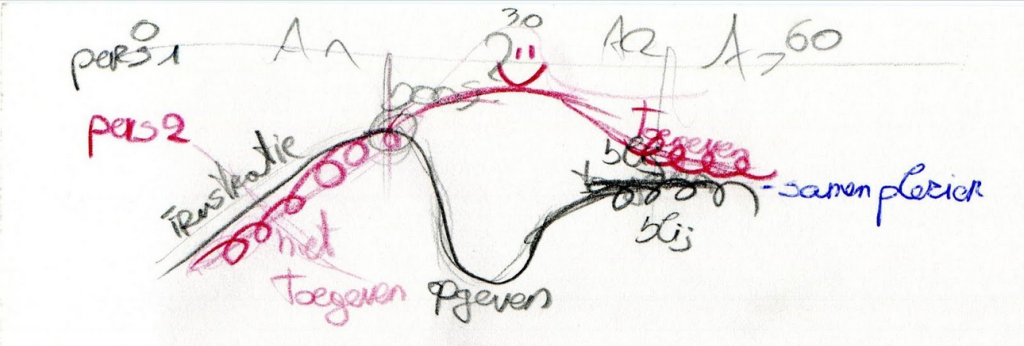In this class, which takes place at the beginning of the year, Jeroen D’hoe uses his experience as a composer of film music to introduce a symbolic language to describe the evolution, dynamic composition and mood development of a film. Although the technique has its origin in film score composition (and thus implies a traditional collaboration between film makers and composers) Jeroen adapts it to the needs of an equal creative collaboration, for instance by emphasizing the importance of continuous feedback between the visual layer and the audio layer.
- It is a non-verbal, non-auditory and symbolic language, which means it is not dependent on the jargon used in film production or music composition. It can thus be easily used by people from all kinds of backgrounds who participate in the preproduction.
- It is not a fixed language and collaborators can agree to introduce new symbols, based on the needs of a production. Therefore the language does not restrict or interfere with the creative process.
- It is structured around the construction of a timeline. Its functionality resembles that of a script, without having the disadvantage of limiting the composer’s possibilities for creative input.
- Contrast. Collaborators can define at which moments in the timeline new elements are introduced, that contain a breach of style with previously used elements.
- Continuity. Collaborators can define when, and in what form, elements that have been previously used reappear later on during the production, or how the flow of a specific sequence is devised (e.g. gradual or crescendo).
Sketches
At first, quick sketches are made to a general atmosphere or progress without relying on specific visual or acoustic information.

It is interesting to note how words are being used, albeit to denote abstract concepts, and very often refer to emotions, such as curiosity, happiness and sadness. These are also enforced by the use of emoticons.

Elaboration into storyscore
These sketches are continuously refined, with addition of visual and musical ideas, and finally evolve into documents that prepare the filmmaker to the animatic phase and the composer to the musical notation phase. The example below, containing musical information in the lower frame and visual information in the upper frame, shows that the creation of a storyscore can be a creative act that already gives strong indications about musical and visual decisions.

The storyscore for the film ‘Worlds’. It shows that the authors are opting for an artisanal style, relying on sketchy lines and a handdrawn atmosphere. The document also hints at a journey structure regarding temporal organisation of events.
Other examples show that especially the visual style becomes apparent in the storyscore. Nonetheless, closer examination of the acoustic information reveals important information regarding dynamics, rhtyhm, contrast and continuity, instruments, tone and sound.

Storyscore for the film ‘Duality’. The modern, sharp design of this document indicates that an artificial approach will be taken, with a well-considered choice for a mathematical art style.